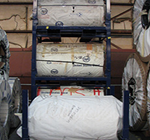Factors to Consider When Determining the Pallet Rack Capacity
In warehouses pallets are commonly used to store products that're either in progress or completed. These pallets are typically stacked on racking systems often constructed from steel. Known as a racking system it helps ensure the safe handling of stored goods, with the use of material handling equipment.
Pallets have an upper surface that stores the product, while there are beams or a frame beneath, which allows a person or equipment to hold the product along with the pallet. Warehouse pallet racking systems have gained traction because of these beneficial features, which help avoid damage and breakage. They keep the products safe and organized, making immediate shipping easy. Each of these pallet rack systems has a maximum load-bearing capacity, and this value is essential as heavy-duty goods are stocked onto each other. Hence, it is essential to know the right pallet racking weight capacity and rack frame capacity for reliable storage. This post discusses the significance of pallet racking weight capacity and factors to consider when calculating the same.
Why it is Important to Know Your Pallet Rack Capacity?
Pallet rack capacity is ideally the distance between the beam and the floor. In contrast, pallet rack frame capacity is the total weight of the products that the frames can support. It is very important to be aware of the pallet capacity before arranging the items. This ensures the safety of the warehouse and the workers. When pallet racks are overloaded it can cause accidents and harm both the racks and the items stored on them. Being aware of the weight capacity of pallet racking is crucial to prevent losses and maintain organization and safety of goods. Thus it’s essential to consider the weight capacity of racks when setting them up for your goods.
What Are Pallet Racking Frames?
Rack frames are the vertical components of a pallet racking system. These frames make storing lucid. Racking frames are flexible and can be adjusted according to the requirement. The thickness and dimensions of these frames as well as the distance between the two beams that join them are significant aspects in determining their load-bearing capacity. The larger the distance, the lesser the weight-bearing capacity.
Understanding Weight and Pallet Rack Beam Capacity
When it comes to ensuring the safety and efficiency of warehouse operations, understanding load limits and the capacity of pallet rack beams is crucial. This knowledge helps in preventing accidents, avoiding damage to goods, and maintaining an organized storage system. Here are the key aspects to consider:
Pallet Rack Weight Capacity
1. Definition: Pallet rack weight capacity refers to the maximum weight a pallet rack system can safely support. Exceeding this limit can lead to structural failure, posing significant risks to both personnel and products.
2. Importance: It’s important to stick to weight limits to avoid accidents and make sure the racking system lasts. Putting weight on it can cause beams to bend racks to collapse and goods to get damaged.
3. Calculation: To accurately determine pallet rack weight capacity, consider the weight of the products, the weight of the pallets themselves, and any additional dynamic forces that may occur during loading and unloading.
Pallet Rack Beam Capacity
1. Beam Length: The length of the beams plays a vital role in determining their load-bearing capacity. Longer beams tend to have lower capacity because the weight is distributed over a larger area, increasing the risk of deflection. Therefore, it’s important to balance beam length with the weight and size of the products being stored.
2. Material and Design: The pallet rack beam capacity also depends on the materials used and the design of the beams. High-quality steel beams with reinforced design features can support heavier loads. Be sure to check the manufacturer’s specifications for each type of beam.
3. Spacing and Configuration: The distance, between the beams and the layout of the racking system impact how weight it can hold. Having beams closer together usually makes the system better, at handling loads. Also using cross ways to reinforce it can increase its load capacity.
Factors to be Considered While Determining the Pallet Rack Capacity
Pallet rack capacity varies due to various reasons, including the type of material being used, rack design, and more. However, the following are some essential factors that you must consider for determining a pallet rack capacity:
- Pallet Weight and Dimensions: This is one of the most important factors for determining load capacity and ensuring that the pallet is sturdy enough to hold the required weight. A pallet’s height, weight, and depth are measured for arranging the beams and even the distribution of pallets.
- Beam Length: To determine the length of the beams, the first thing to be sure about is the width of the pallets and the number of pallets per beam. This is because when the beam length increases, it reduces the capacity to hold heavy weights. Therefore, you can increase the beam length if the items are in bulk but not heavy.
- Vertical Beam Spacing: Vertical beam spacing is crucial to determine the pallet rack frame capacity. Higher vertical beam spacing results in lower upright frame capacity, which can be changed according to the item’s weight.
- The capacity of Upright Frame: Upright frame capacity is the distance between two beam levels. This depends upon vertical beam spacing, beam weight, and other aspects of a pallet rack system.
If you plan to invest in some good pallet racks for your warehouse, then ensure the weight and quantity of the products to be stored on these pallet racking systems. Also, while buying pallet racks for your warehouse, ensure to partner with a trusted and reliable manufacturer. SPS Ideal Solutions is a leading provider of various storage systems, including pallets, racks, storage containers, and so on. The company manufactures high-quality warehouse pallet racking systems for reliable integration. In addition, the experts at SPS Ideal Solutions will also help you choose pallet racks with the suitable capacity required for your products. Get in touch with the team at SPS Ideal Solutions today to know more.
Frequently Asked Question About Pallet Rack Capacity
How do you calculate rack load capacity?
When figuring out how weight your rack can hold, first make sure you know all the details, about your racking system like beam sizes and how the frames are built, especially the vertical beam spacing. Then add up the weight of everything you’re going to store on it including the pallets themselves. Spread this weight evenly across the beams to keep things balanced.
Check out what the manufacturer says in their guidelines and specs about load ratings. This info tells you how weight each part of your racking system can handle safely. By sticking to these steps and giving some room, for safety you can work out. Maintain how much your pallet racking system can hold while keeping things safe and running smoothly in your warehouse.
What is the pallet rack beam weight capacity?
The pallet rack beam weight capacity refers to the maximum amount of weight that a single beam in a pallet racking system can safely support. This capacity is determined by several factors, including the beam’s length, material composition, and design specifications. Longer beams generally have lower weight capacities due to the increased span and potential for deflection under heavy loads.
It’s crucial to consult the manufacturer’s specifications for each type of beam used in your racking system to ensure it can support the intended weight without compromising safety or structural integrity. Distributing the load evenly across the beams and adhering to recommended safety margins are essential practices to maximize the beam’s weight capacity and maintain a secure warehouse environment.
What is the maximum warehouse racking weight capacity?
The maximum warehouse racking weight capacity refers to the overall load-bearing capacity of an entire pallet racking system within a warehouse. This capacity depends on various factors, including the structural design of the racking system, the type and quality of materials used, and the configuration of upright frames and cross beams. It’s determined by calculating the cumulative weight of all stored products, pallets, and any additional dynamic loads such as handling equipment or seasonal inventory fluctuations.
Ensuring that the warehouse racking system is installed and maintained according to manufacturer guidelines and industry standards is crucial for preventing overloading, which can lead to structural failure, damage to goods, and safety hazards. Regular inspections and adherence to load limits are essential practices to ensure the maximum warehouse racking weight capacity is safely and efficiently utilized.
Related Posts:
- https://www.spsidealsolutions.com/5-important-reasons-for-pallet-racking-system-damage/
- https://www.spsidealsolutions.com/how-to-optimize-the-space-on-pallet-rack-system/
- https://www.spsidealsolutions.com/how-does-adjustable-pallet-racking-system-optimize-warehouse-storage-efficiency
- https://www.spsidealsolutions.com/how-to-choose-storage-rack-system-for-warehouse/
About The Author











